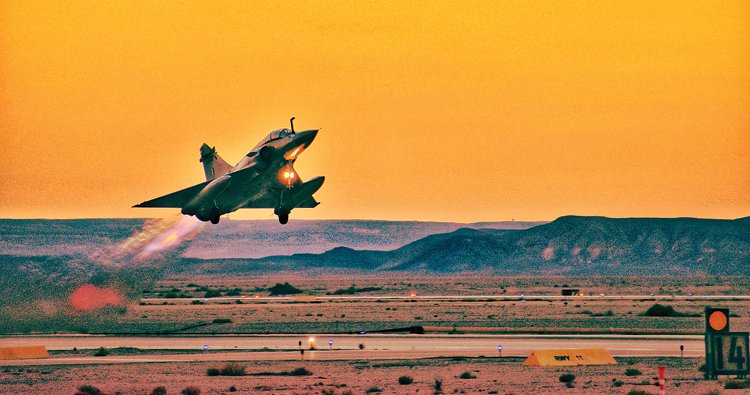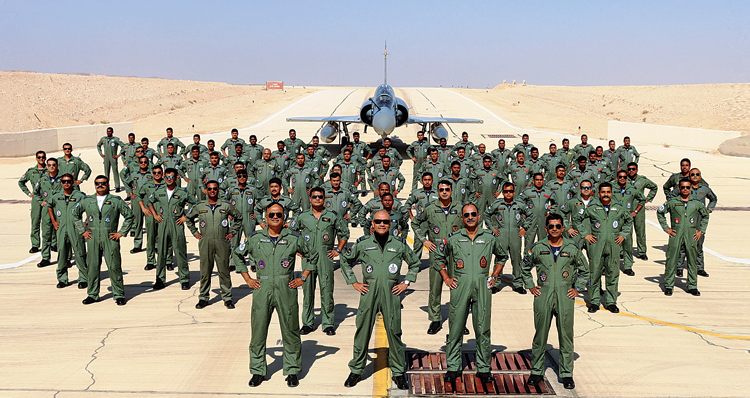INDIAN ARMED FORCES CHIEFS ON OUR RELENTLESS AND FOCUSED PUBLISHING EFFORTS

The insightful articles, inspiring narrations and analytical perspectives presented by the Editorial Team, establish an alluring connect with the reader. My compliments and best wishes to SP Guide Publications.

"Over the past 60 years, the growth of SP Guide Publications has mirrored the rising stature of Indian Navy. Its well-researched and informative magazines on Defence and Aerospace sector have served to shape an educated opinion of our military personnel, policy makers and the public alike. I wish SP's Publication team continued success, fair winds and following seas in all future endeavour!"

Since, its inception in 1964, SP Guide Publications has consistently demonstrated commitment to high-quality journalism in the aerospace and defence sectors, earning a well-deserved reputation as Asia's largest media house in this domain. I wish SP Guide Publications continued success in its pursuit of excellence.
- The layered Air Defence systems that worked superbly, the key element of Operation Sindoor
- Operation Sindoor | Day 2 DGMOs Briefing
- Operation Sindoor: Resolute yet Restrained
- India's Operation Sindoor Sends a Clear Message to Terror and the World – ‘ZERO TOLERANCE’
- Japan and India set forth a defence cooperation consultancy framework, talks on tank and jet engines
More Advanced, More Innovative ‘Blue Flag’ 2021
After two weeks that filled Israeli skies with fighter jets from around the world, the fifth Blue Flag exercise ended with each participating air force returning with the experience and knowledge gained at the largest and most advanced international exercise ever held in Israel

In 2013, the Israeli Air Force (ISAF) held the first-ever ‘Blue Flag’ exercise - an Israeli international exercise that includes just three participating nations: the United States, Greece, and Italy. This year, those three countries have returned for the fifth time, only this time they were joined by air forces from four additional countries: Germany, France, India, and the UK. Over two weeks, challenges evolved, new training methods introduced and capabilities improved - this is ‘Blue Flag’ 2021 held from October 17–28, 2021.
This years’ exercise, which has been held every two years since 2013, was the largest and most diverse yet - eight air forces, 75 aircraft, over ten different platforms, 1,500 participants, and two weeks of challenging aerial drills and joint missions. The exercise is of tremendous strategic-international importance to the State of Israel, and acts as a bridge for regional cooperation and enhancement of shared capabilities.
The exercise included the German Air Force and Royal Air Force, each with six Eurofighter jets, as well as the United States Air Force with six F-16CJ fighters, the Italian Air Force with five F-35s and a Gulfstream G550, the Hellenic Air Force with four F-16s, the French Air Force with four Rafale fighter jets, and the Indian Air Force with five Mirage 2000 aircraft. From the Israeli Air Force, 12 “Adir” F-35I jets from the 116th (“Lions of the South”) and 140th (“Golden Eagle”) Squadrons participated, as well as six “Baz” (F-15) jets from the 106th (“Edge of the Spear”) Squadron, nine “Sufa” F-16Is from the 119th (“Bats”) Squadron, and six “Barak” F-16C/D planes from the 115th (“Flying Dragon”) Squadron. Additionally, many countries arrived as exercise observers. Among those countries were Finland, South Korea, Japan, the Netherlands, Australia and more.
FROM THE COCKPIT TO THE DEBRIEF ROOM
As the largest international exercise ever held in Israel, preparations were extensive and began over a year ago. The 106th (“Edge of the Spear”) Squadron led the planning along with the 115th (“Flying Dragon”), the ISAF’s aggressor squadron. One of the more significant challenges in preparation and execution was the integration of fourth and fifth generation aircraft, as it was the first time Israeli and Italian F-35s took part in the training. “Fourth and fifth-gen aircraft have different capabilities and missions that are specific to each platform”, explains Commander of the 115th Squadron. “The fact that they fly together in combined formations is definitely challenging, so our job was to find the right balance in the red force and level of difficulty”.

Throughout the exercise, forces performed many joint flights that simulated combat scenarios. At the end of each one, aircrews and other participating personnel gathered for debriefings conducted with advanced IAI (Israeli Aerospace Industries) systems and led by the avionics department of the IAF’s Materiel Directorate, in cooperation with the 115th Squadron. Details from each flight could be viewed and dissected - who got hit, which teams succeeded in their missions and more. The debriefing aspect this year, was especially challenging due to the large number of participants, wide-variety of aircraft and tight schedules.
A BRIDGE FOR REGIONAL STABILITY
While the ‘Blue Flag’ exercise was designed to train fighter squadrons, it also provided a great opportunity for other divisions to learn and improve. One notable example was the Air Defence Division - a “Yahalom” (Patriot) battery simulated enemy SAMs (Surface-to-Air-Missiles) as part of the aggressor force in the exercise. The Air Control Division also played a role in the large-scale drill, as the men and women of the Air Control and Air Traffic Control School at Uvda Air Force Base took on the important task of managing the airspace. This year, German Air Force air controllers joined a team of Israeli controllers, which strengthened the cooperation between the forces and allowed for beneficial mutual learning.
A “BLUE AND WHITE” INTERNATIONAL EXERCISE
Uvda Airbase is no stranger to foreign languages - as Israel Air Force’s main deployment base, it is well-equipped for hosting air forces from around the world. The base record was broken when seven different countries arrived to take part in the ‘Blue Flag’ exercise, leaving not a single hangar empty. Hosting an exercise of this scale is a not an easy task. Nevertheless, the personnel at Uvda AFB rose to the occasion and prepared accordingly: “There’s a cultural difference between hosting Israeli squadron and allied squadrons”, explained the Commander of Uvda AFB. The exercise was held in spite of the COVID-19 Pandemic, while adhering to all of the health guidelines and precautions. Each participant has been vaccinated and tested.
“This year’s ‘Blue Flag’ is the largest and most advanced one to date”, said Brig. General Amir Lazar, Head of the ISAF Air Division. “Even though this is an international exercise, we are focusing on tasks that are familiar to the Israeli Air Force, so we are holding an international exercise with a hint of ‘blue and white’. We are dealing with airspace defense, and border defense, a field that other countries have less experience in than we do, as well as depth strikes and ground force support. The exercise also includes ‘red’ aggressor forces led by the 115th (“Flying Dragon”) Squadron, and SAM (Surface-to-Air Missile) batteries that simulate enemy anti-aircraft fire”.

Almost every international exercise includes the challenge of integrating different platforms and technologies, though this year, an additional challenge was introduced - the integration of Israeli and Italian F-35 fifth-generation fighters with fourthgen aircraft. Fifth-gen aircraft receive more mid-flight data that helps them build an accurate aerial image. While flying with other aircraft, they must be able to present that image in the most efficient way possible. Moreover, there is a different balance of personnel between the command posts and the mission leaders in the sky, since the platforms are capable of making many decisions that fourth generation fighters cannot. This change is being drilled for the first time in the current exercise.
International exercises include the challenge of integrating different platforms, though this year, an additional challenge was introduced - the integration of F-35 fifth-generation fighters with fourthgen aircraft
“At our home base, we are used to training with a maximum of 12 aircraft, all the same platform”, shared Captain Andrew, an F-16 pilot and project officer of the American fighter wing deployment to Israel. “Blue Flag has a wide variety of platforms, and the difference between platforms in the flight formations themselves allows us to learn from their capabilities. The large number of aircraft also helps us focus on flight coordination, which is a critical aspect of any large-scale operation that we’d need to perform. This exercise is very challenging, but the challenge is essential as it reflects the level of training that we aspire to reach”.
FLYING HIGH TOGETHER
Unlike most international exercises, ‘Blue Flag’ hosts all participants at one base. Forces don’t only fly together, but also hold joint briefings and debriefings. The shared experience allows for deep mutual learning which enables participants to form relationships that could not have been built through the radio communication systems in their aircraft.
Flight Lieutenant Aakash, a Mirage 2000 pilot in the Indian Air Force said, “Each air force has its own culture, both professionally and socially. Understanding how each force operates is a unique experience for us. We learn from other nations and they learn from us, that’s how we manage to improve and become a better air force”.
The last three days of the exercise simulated an ongoing warfare scenario where each day affects the next. For instance, if the “enemy” force were to strike storage facilities on the first day, there will not be enough munitions to fight on the second and adaptations must be made. In the complex reality of a war, it’s important for the Air Force to be ready for joint combat. Exercises like ‘Blue Flag’ improve cooperation between the forces and ensure that in an event that all nations would have to fight side-by-side, they could do so in the best way possible. “The challenges we face are only increasing, and so we must always be one step ahead of our enemies”, stated Commander of the Israeli Air Force, Major General Amikam Norkin. The ‘Blue Flag’ international exercise ended after two weeks of intensive training and cooperation at Uvda AFB.
Apart from the exercise itself, other historic events in the field of international cooperation took place. In the first week of the exercise, the IDF Chief of the General Staff, Lt General Aviv Kochavi, awarded a medal of appreciation to the Commander of the German Air Force, and the German Ambassador to Israel awarded a decoration to IAF Commander, Major General Amikam Norkin. Additionally, the commanders of eleven different air forces arrived at Uvda AFB for a monumental event, including the Commander of the United Arab Emirates Air Force, Major General Ibrahim Nasser Mohammed Al Alawi, who arrived for a historic visit in Israel for the first time since the signing of the Abraham Accords. Major General Norkin addressed the distinguished visitors and explained the significance of the ‘Blue Flag’ exercise: “Mainly in this area, the Middle East, I look at aerial diplomacy and the relations between us as a bridge to regional stability. What we do between us, between the Air Force commanders, is a bridge and foundation that nations can work upon on other issues”. Afterward, they participated in one of the exercise’s flight briefings, toured the various aircraft shelters, and spoke with exercise participants in order to experience and learn about ‘Blue Flag’ first-hand.





